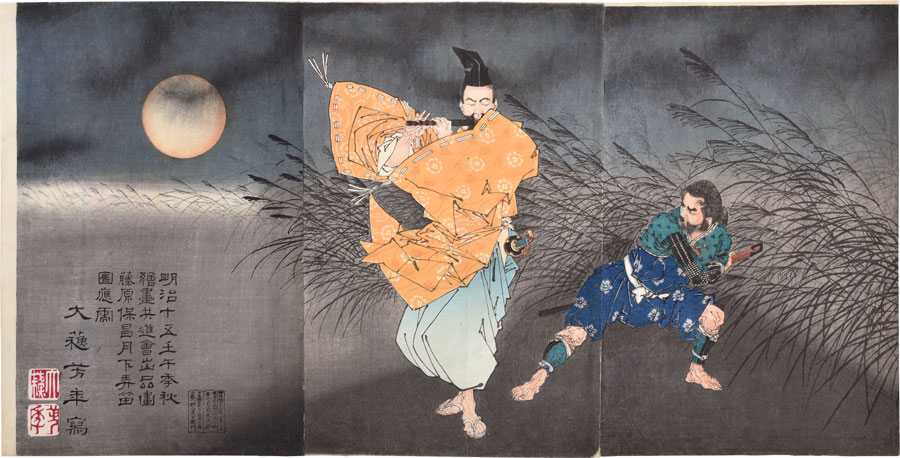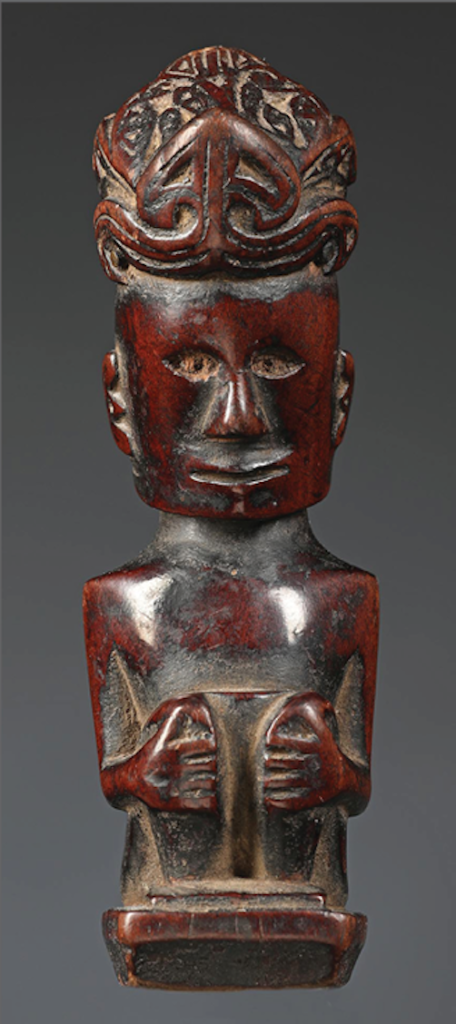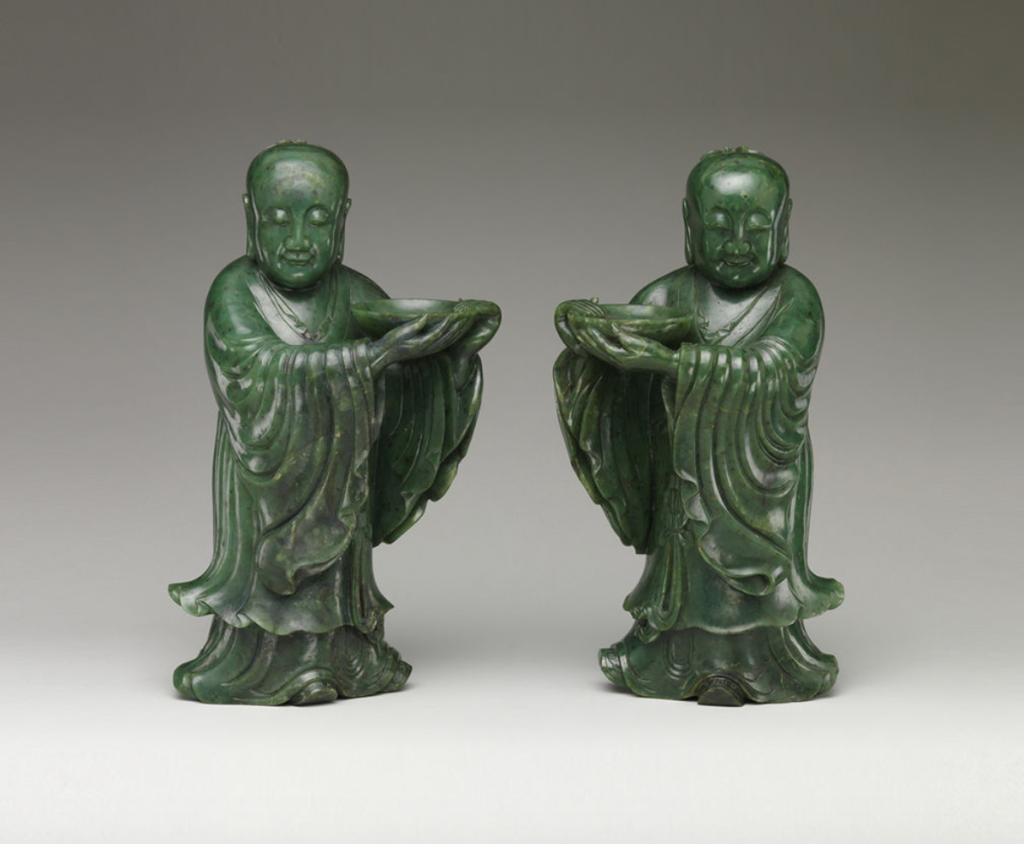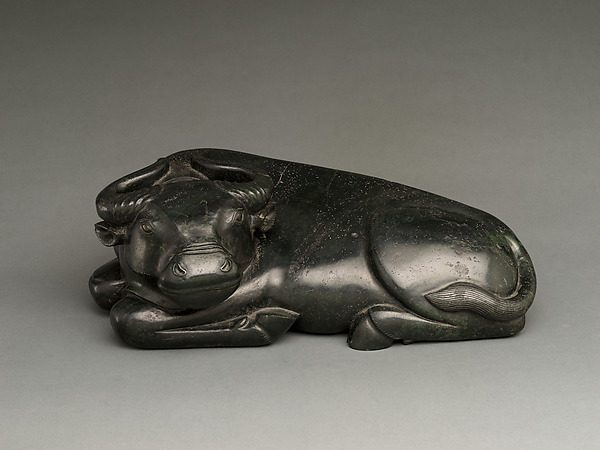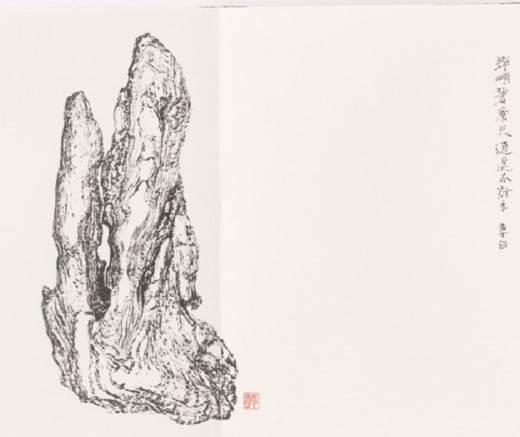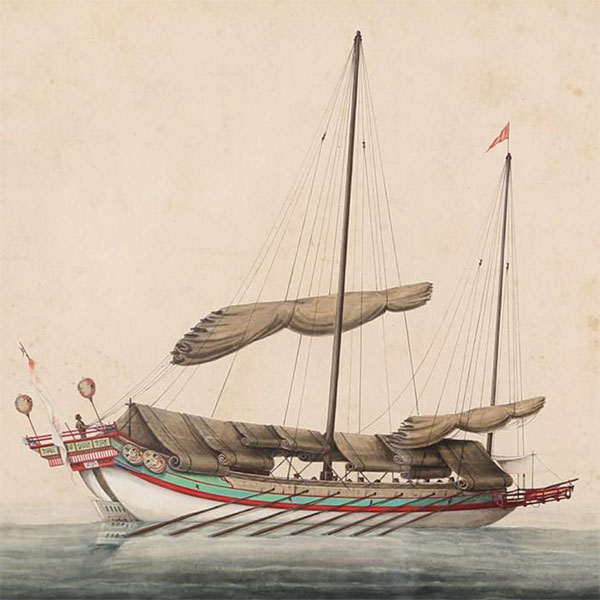Tsukioka Yoshitoshi (1839-1892), Fujiwara Yasumasa Plays the Flute by Moonlight, ca. 1883, woodblock printed triptych, 14 1/8 by 28 1/2 in., 36 by 72.4 cm. Scholten Japanese Art
Asia Week New York is almost here. We are very excited to present the 12th annual Asia Week New York, which continues to delight collectors and connoisseurs with its spectacular trove of Asian works of art–both ancient and contemporary– spanning the Far East and South Asia. Opening on March 11th through March 20th, the 29 international galleries will present their exhibitions virtually and by-appointment, with six auction houses–Bonhams, Christie’s, Doyle, Heritage, iGavel, and Sotheby’s mounting their respective sales.
Says Asia Week New York chairman Katherine Martin: “We are very pleased to have a significant number of participants this year. Up until the pandemic, Asia Week New York focused our energies on the March event, and we also supported our exhibitors who participated in the smaller September Asia Week schedule. However, the ‘new normal’ prompted us to consider a new direction, so we decided to extend membership to dealers, auction houses and museums on an annual basis, which allows us to provide additional and sustained outreach through our website and social media platforms as well as a program of virtual panel discussions throughout the year.”
This year the wonderful and varied works at Asia Week New York’s participants can be viewed in an online exhibition featuring all 29 galleries and highlights from the sales at the six auction houses. 13 gallery exhibitions and viewings at five auction houses are open by-appointment and free to the public. Each reveals the rarest and finest examples of Asian ceramics, paintings, prints, textiles, sculpture, jewelry, bronzes, representing artistry, ingenuity and imagination from every time period and corner of Asia.
Organized by category, here is a round-up of the highlights at the galleries:
Ancient and/or Contemporary Indian, Himalayan, and Southeast Asian Art
Among the offerings at Art Passages is A Bird and Blossoms, a Safavid period tile, circa 17th century. Richly illustrated with a scene depicting a multi-colored bird in flight approaching a blossoming branch and a cypress tree, this was part of a larger composition inspired by the natural world and used to decorate the walls of palaces and houses of the nobles in Isfahan, an Iranian city known for its Perso–Islamic architecture, grand boulevards, covered bridges, palaces, tiled mosques, and minarets. Online only
Prahlad Bubbar will present a series of outstanding works from the Persian, Indian and Himalayan worlds, connected to the theme of his exhibition, The Abundance of Nature, which reflects the innate generosity and regenerative power of nature, a quiet observer in all these works. Krishna, Radha and Yamunaji Dance in the Lotus Ponds of the Yamuna–a rare and remarkable pichhvai (devotional Indian paintings) from Kota or Nathdwara– illustrates a masterful interpretation on textile of Krishna playing his magical flute in tribhanga pose amongst a web of lotus blossoms. Online only
Among the notable Indian paintings at Oliver Forge and Brendan Lynch Ltd, is Rustam before Kai Kavus having knocked down Tus, Folio from a Shahnama, circa 1610, a rare survivor from the court of Ibrahim Adil Shah II (1571 – 1627), the fifth sultan of Bijapur, who was a great patron of music and painting. The extraordinary quality of the paper used is incredibly thin, refined and burnished and is in near impeccable condition. The lavish use of gold leaf is one of the hallmarks of painting in the Deccan and gives us a glimpse into the confident opulence of the world of the Bijapur court under the Adil Shai sultans. Online only
This rare and exquisite 17th century gilt copper and blue champlevé enamel container or pandan, Mughal, from North India–featured at Francesca Galloway–was intended for the storage of betel nut and belongs to a group of four gilt copper enameled pandans to survive from this period. Only the most skilled craftsmen with substantial knowledge of the highly complex firing processes, were able to produce enameled objects. Two of the pandans from this group are now in the Victoria and Albert Museum and in the Jagdish and Kamala Mittal Museum and the third is now available at Francesca Galloway. Online only
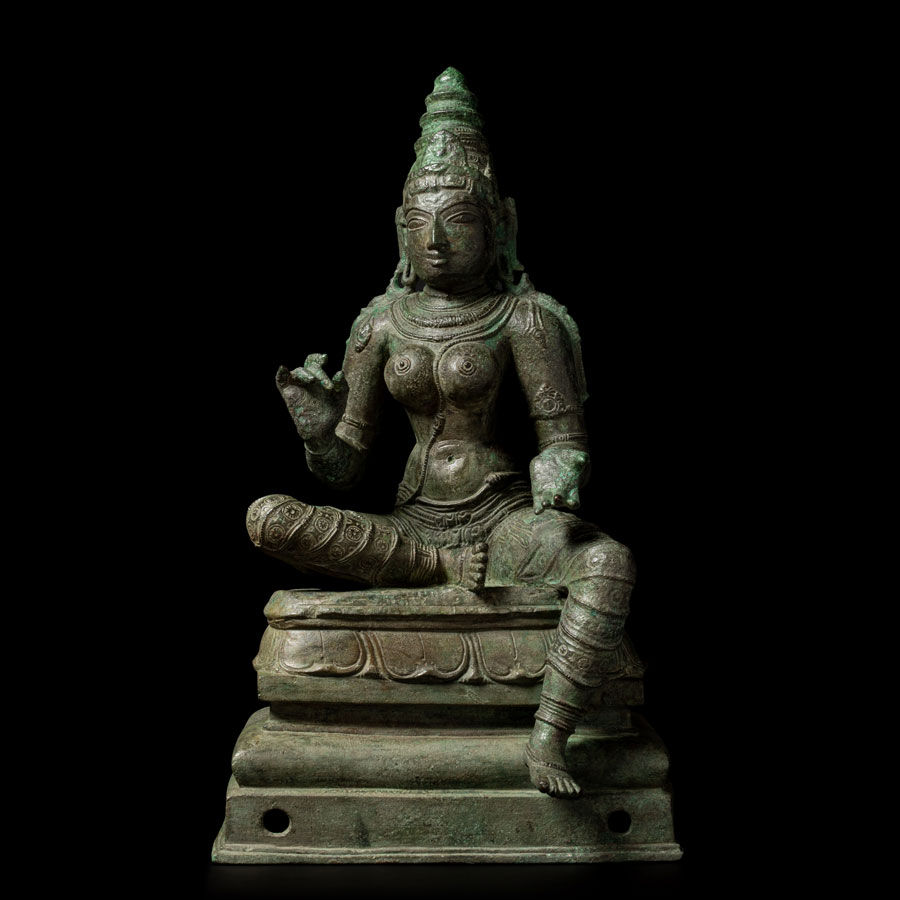
Uma (Parvati), South India, Tamil Nadu, Chola period, 11th-12th century, Copper alloy, 15 x 8.5 in. (38.1 x 21.59 cm.), Kapoor Galleries Inc.
Uma (Parvati) stands guard at Kapoor Galleries. This striking 11th-12th century Chola bronze deity from Tamil Nadu, is representative of the most important of South Indian Hindu temple images; it is part of a 'Somaskanda' image which describes the divine family constituted by Shiva, Parvati and Skanda. The present figure of Parvati, or ‘Uma’ in the native language of Tamil Nadu, seated in the posture of royal ease, belonged to a group of three portable bronze images essential to worship within each South Indian temple. The bronze figure is also processional, as indicated by the holes fit for poles enabling worshippers to carry the divine figures into the streets for all to experience darshan. 34 East 67th Street, for gallery hours, phone 212-794-2300
Thomas Murray presents an early 19th/early 20th century Nuo Mask of a Wise Leader, from southwest China. Rooted in a shamanic/animistic tradition dating back thousands of years and preserved in remote mountains by the tribal minorities of Southwest China, the dramas feature heroic battles between the forces of good and evil and serve as a means to drive out devils and malevolent ghosts. This mask is thought to capture the character of a wise but strong leader; it comes from an old French collection and is one of the finest known. Online only
At Susan Ollemans’ exhibition, Recent Acquisitions of Asian Jewelry 8-19th century, a spectacular 19th century gold pectoral from Sumba, Indonesia stands out among her stunning collection of jewelry and adornments. Made from a single rod of gold, it was hammered out into two triangular flanges. This piece would have been part of a nobleman’s treasury and exposed to daylight only for ritual purposes and under the guidance of a priest. Online only
Route Map of Experience, by Jayashree Chakravarty at Akar Prakar is a monumental work in two parts, one measuring 10.5 ½’ x 41’ and the other 10.5’ x 14.5’. Chakravarty creates immersive painted installations, comprising great, supple, and shape-shifting walls of rice paper, tissues, fabric and brown paper. In them, she arrests fleeting moments from the flux of experience. This is space where she can hold conversations with her inner self. As the eyes get used to this monumental twilight landscape, the details begin to reveal themselves. It’s as if some natural formations were playing with your vision in the semi-darkness and creating fantastic images in your mind’s eye. Online only
Made as a unique commission for a person of importance and taste, this 17th century Khatamkari dagger from the Ottoman Empire is one of the rarities on view at Runjeet Singh. The carved wooden handle and case is inlaid with gold, mother of pearl, ebony and ivory. Khatamkari refers to a technique that originated in Persia, most probably Shiraz and Isfahan, and travelled throughout the Middle East and India. Online only
Ancient and/or Contemporary Chinese Art
Spring 2021 Exhibition of Chinese Porcelains and Works of Art, at Ralph M. Chait Galleries, will feature a magnificent Chinese green porcelain bowl with the Imperial mark–a very rare type and usually dated toward the beginning of the Kangxi reign. The decorative motif of eight sacred horses leaping over waves strewn with precious things originates from the early Ming dynasty. The vibrant colors combined with this classic decoration was a bold artistic expression of the Kangxi period in the pages of Chinese history. 16 East 52nd Street,
10th floor, for gallery hours, phone 212-397-2818
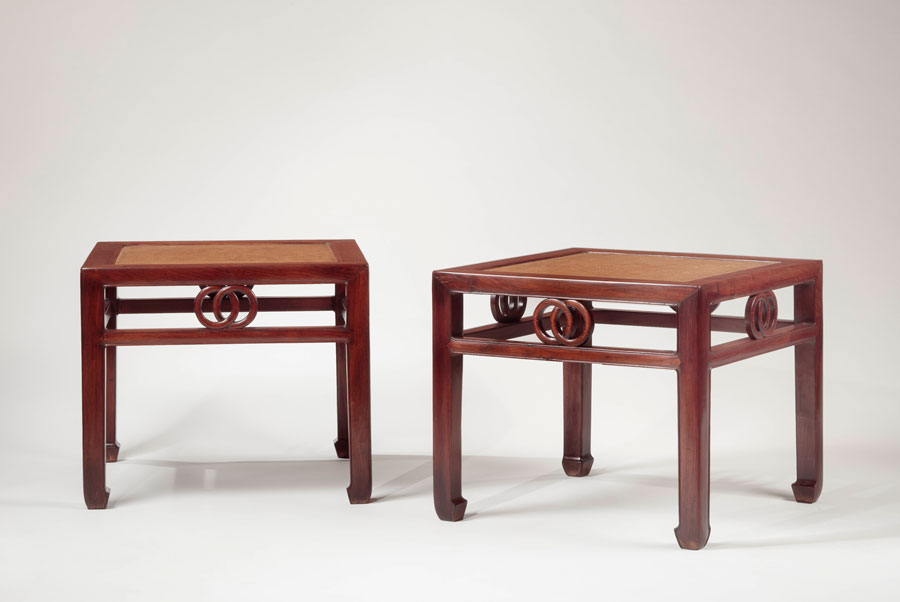
A pair of hongmu square stools, Qing dynasty, Kangxi period, early 18th century, height 47 cm / 18 1/2 in, width 55.6 cm / 21 7/8 in, depth 55.6 cm / 21 7/8 in. Nicholas Grindley LLC
A pair of early 18th century hongmu square stools, from the Qing dynasty, Kangxi period, is among the offerings at Nicholas Grindley LLC. What is particularly interesting about these stools, especially when they survive in pairs, is their scale. They are rarely 22 inches square, making them not only particularly useful as end tables in a domestic setting, but also strong enough to stand on their own in a museum installation. Online only
On view at Ink Studio, is Almost Full Moon, by Peng Kanglong, a literati-recluse artist who paints in the traditional landscape and flower genres and is considered the singular artist of modern times. His major stylistic influences include the 17th century Monk artists Shitao and Kuncan, as well as the Modern landscape master Huang Binghong. In classical Chinese painting there are three major subjects—the figure (including portraiture), landscape, and plants and flowers. Kanglong’s painting epitomizes the best in his category. Online only
Among European admirers of Asian art was the incomparable Swiss artist Alberto Giacometti (1901-1966). While conversant with Chinese painting, Giacometti might not have known that his signature cast-bronze sculptures with surfaces appearing rough, crusty, and eroded, the human and animal forms attenuated, their limbs stretched thin and spindly, had predecessors in the ancient art of China. From the standpoint of Asian art specialists, the oxen featured in Earthly Agendas at Kaikodo LLC– are clear examples of a Han period regional artistic norm. Presently they serve as appropriate symbols of this lunar year, advancing under the spell of the metal ox. Online only
A veritable “Treasure Box” of ancient objects deserves attention in Ceramics and Works of Art from China, Japan and Korea, the exhibition at Zetterquist Galleries. Housed in this magnificent 18th century scholar’s objects box are relics dating from the Shang to Ming Dynasties. With a lid and two doors, it is constructed of huanghuali with recessed white copper hardware, and each tray and drawer has been custom-fitted for 13 ancient gilt and silvered bronze, stone and porcelain objects. In the left drawer sits a rare revolving porcelain stem-cup with Qingbai glaze from the Yuan Dynasty, a 12th -13th century Cambodian bronze necklace is in the top drawer and a Tang Dynasty gilt and silvered lotus-shaped chariot hubcap beckons from the bottom drawer. 3 East 66th Street 2B, by appointment
Ancient and/or Contemporary Japanese Art
In the foothills of the mountains, Atagoyama 1932; Fall and Summer is one of several woodblock prints on view at The Art of Japan. This print depicts Fall and Summer views of Mt. Fuji. Merely by altering pigments, baren techniques and adding a block to create the effect of rain, the publisher and artist worked together to create two completely different moods using essentially the same blocks and the same subject. Although these designs were published in an edition of 200, they have become scarce, and because of the large format, they are difficult to find in fine condition. Online only
Chambers Fine Art, which specializes in Asian contemporary works of art, turns its attention to a young Japanese artist for its return to Asia Week New York. In Egami Etsu: Facebook a single artist show debuts the work of Egami Etsu, the 26-year old Japanese artist, who is in New York on an artist residency program sponsored by the Japanese Ministry of Cultural Affairs. 55 East 11th Street, by appointment only
Dai Ichi Arts, Ltd., will present Erosion, a ceramic work by Shingu Sayaka, a young emerging ceramist, in the exhibition, The Passage of Time. Internationally recognized for her ceramic flower series, her work represents transience, fleetingness and immortality. 18 East 64th Street, by appointment
Egenolf Gallery Japanese Prints is presenting Chiura Obata (1885-1975): Woodblock Prints and Paintings. One of the highlights in this single artist exhibition is Evening Glow at Mono Lake, from Mono Mills (1930), one of the finest designs from the “World Landscape Series: America”, the ground-breaking effort which represents the apogee of woodblock printing in the 20th century. Obata collaborated with the Japanese publisher Takamizawa, who employed more than 32 carvers and 40 printers for eighteen months for this project. Each of the finished prints in the series required between 120 and 205 separate hand printings, and some required 15 to 20 blocks just to replicate a single brushstroke. Although a professor at Berkeley, in 1942 Obata and his family were incarcerated at the Topaz internment camp, where he then opened an art school for fellow internees. His colleagues at Berkeley were able to preserve many of his artworks; he returned to teaching there in 1945. Online only
Toto ryogoku yusen no zu (View of pleasure boats at Ryogoku, the Eastern capital), a polychrome triptych woodcut by Utagawa Hiroshige, is one of the woodblock prints available at Hara Shobo. It’s a traditional scene depicting pleasure boats on the Sumida River with people gathering to celebrate beginning of summer and view fireworks from the Ryogoku Bridge, on the riverbank of the Sumida River. Online only
Utagawa Kunisada (1786-1865): His World Revisited is the single artist exhibition at Sebastian Izzard LLC Asian Art, which showcases A Tipsy Courtesan from Fukagawa, from the series: Three Fashionable Tipplers, signed Gototei Kunisada. This very lively and expressive woodblock print portrays a hard-drinking Fukagawa geisha drinking wine from a crystal goblet with a cup of sake ready in the other. She can indulge in alcohol for seven days and nights without ill effect, and once drank a total of one hundred shots and one hundred “bull’s eyes” in five days, earning her the title of itagashira, given the highest-ranking women in the local argot. 17 East 76th Street, 3rd Floor, by appointment
Master of an enormous range of glazes, Kitaoji Rosanjin (1883-1959) produced superb functional vessels and tableware in stoneware and porcelain that were initially created for his celebrated and exclusive eating club in Tokyo. Today, globally, Rosanjin, whose work will be on view in the exhibition–Tradition Redefined: Rosanjin and His Rivals–at Joan B Mirviss LTD., is the best-known Japanese ceramist of the twentieth century. This powerful vessel of 1955 flaunts Rosanjin’s genius for imbuing a classical form with a striking sense of modernity–– in terms of form, with the thick rising neck, texture, with the irregular rippling combed lines and surface patterning, with the flung splashes of mottled glaze. 39 East 78th Street, 4th floor, by appointment
One of the most recent works that Ōsumi Yukie has produced, Araiso, or ‘Rough Shore’ on view at Onishi Gallery references the artist’s signature motif: the ceaseless movement of nature. Ōsumi employs a centuries-old technique known as nunomezōgan, or ‘textile imprint inlay’ in which the surface of the object is incised with a fine chisel, then inlaid with gold and lead. 521 West 26th Street, by appointment
One of the highlights in On the Vanguard: Meiji Period Woodblock Prints, the exhibition at Scholten Japanese Art is Tsukioka Yoshitoshi’s masterpiece triptych, Fujiwara Yasumasa Plays the Flute by Moonlight, ca. 1883, easily the artist’s most famous work and one of the most memorable designs from the entire genre of Japanese woodblock prints. It illustrates a dramatic kabuki scene with the famous court musician, Fujiwara Yasumasa (958-1036), playing his flute while passing under a moonlit sky dramatically streaked with dark clouds. ‘The Flute Player’- as he is known, is apparently unaware that his outlaw brother, Kidomaru, is creeping up behind him with the intention of robbing him of his robes but is instead mesmerized by the Yasumasa’s music and leaves his brother unharmed. 145 West 58th Street, Suite 6D, by appointment
Thomsen Gallery will feature a solo exhibition of 10 new works by the Kyoto lacquer artist Yoshio Okada (b. 1977). The exhibition is centered around two series: “Celestial Phenomena” and “Jellyfish.” Ocean creatures resembling multiple moons reflected on the surface of the night sea inspired Okada to create “Jellyfish.” An immersive sense of depth is achieved by executing the decoration in two layers. Okada uses meticulous processes to achieve the lightest and most evanescent of visual effects. The resulting works are compelling fusions of time-honored skills with contemporary sensibility. 9 East 63rd Street 2nd floor, by appointment
This Fallen Pine Needles basket, made from madake, bamboo and rattan, is one of the intricately woven bamboo baskets featured at TAI Modern. Creating complex details and a beautiful sense of depth, artist Monden Yuichi employs a technique he inherited from his father by using long, thin strips of bamboo intertwined in seemingly random layers. To help achieve the tightness of the weave in this piece, Yuichi used a tool he fashioned from the rib of a discarded umbrella. Online only
Gozu Tennō a menacing Buddhist deity with hair rising up like flames and two bull horns emerging from its head, stands guard at Hiroshi Yanagi Oriental Art. In Japan, Gozu Tennō, known as “Ox Head Heavenly King,” was thought to quell epidemics and has been worshipped since the Heian period. The sculpture is exceedingly unusual as it lacks the bull’s head that is commonly perched atop the deity’s human head. Online only
Kokon Biannual: Spring 2021 at Koichi Yanagi Oriental Fine Arts, will present an appropriately titled Landscape, an ink-on-paper hanging scroll, by Kano Motonobu (1476-1559) from the Muromachi-Momoyama period, 15th-16th century. This beautiful landscape painting is a recent and exciting discovery. Motonobu was a talented and politically savvy painter who played an essential role in the success of the Kano school of painters. 17 East 71st Street #4, by appointment
At her namesake gallery, first-time participant, Miyako Yoshinaga, presents a solo exhibition by Tokyo-based Manika Nagare (b. 1979). Manika Nagare‘s abstract color paintings, such as Through a Faraway Eye, are inspired by awe-inducing natural phenomena and nature's boundless vistas. Through these works created during the pandemic, Nagare has sought to express her emotional response to losing loved ones. All elements of her work, such as layers of unmixed colors, lines suggesting mountain ridges, contours of plants, and smooth rhythms like flowing water coexist organically as in nature itself. 24 East 64th Street, for gallery hours, phone 212-268-7132.
Ancient and Contemporary Korean Art
This elegant, yet simple, late 19th century inkstone case, or Yeonsang, at HK Art & Antiques LLC, is a superb example of the wood furniture used in a Sarangbang or scholar’s study. In the Joseon Dynasty, the study was a multifunctional room in the men’s quarters of an upper-class home. Made of persimmon wood, this inkstone case was used to store important scholar’s objects: inkstone, ink stick, brush, and paper, known collectively as the Four Friends. 49 East 78th Street, by appointment only
For gallery hours and auction schedules visit: www.asiaweekny.com






